Five-Year Enhanced Natural Attenuation of Historically Coal-Tar-Contaminated Soil: Analysis of Polycyclic Aromatic Hydrocarbon and Phenol Contents
Abstract
1. Introduction
2. Materials and Methods
2.1. Study Area Characteristics
2.2. Soil Properties and Type of Area Coverage, Including Vegetation and Development
2.3. Determination of the Content of Soil Pollutants
2.4. Soil Remediation Methods
3. Results
3.1. The Content of Pollutants in Soil on the Area of the Industrial Wasteland Prior to the Remediation Commencement
3.2. Selection of Soil Remediation Method
3.3. Phenol Content in Soil after Enhanced Natural Attenuation
3.4. Naphthalene Content in Soil after Enhanced Natural Attenuation
3.5. Three-Ring PAH Content in Soil after Enhanced Natural Attenuation
3.6. Four-Ring PAH Content in Soil after Enhanced Natural Attenuation
3.7. Total PAH Content in Soil after Enhanced Natural Attenuation
3.8. Mean Decrease of Phenol and PAH Content in Soil after Enhanced Natural Attenuation
4. Discussion
5. Conclusions
Author Contributions
Funding
Institutional Review Board Statement
Informed Consent Statement
Data Availability Statement
Conflicts of Interest
References
- Shaheen, S.M.; Antoniadis, V.; Kwon, E.; Song, H.; Wang, S.-L.; Hseu, Z.-Y.; Rinkle, J. Soil contamination by potentially toxic elements and the associated human health risk in geo- and anthropogenic contaminated soils: A case study from the temperate region (Germany) and the arid region (Egypt). Environ. Pollut. 2020, 262, 114312. [Google Scholar] [CrossRef]
- Telesiński, A.; Krzyśko-Łupicka, T.; Cybulska, K.; Pawłowska, B.; Biczak, R.; Śnieg, M.; Wróbel, J. Comparison of oxidoreductive enzyme activities in three coal tar creosote-contaminated soils. Soil Res. 2019, 57, 814–824. [Google Scholar] [CrossRef]
- Brown, D.G.; Gupta, L.; Kim, T.; Young, H.K.; Coleman, A.J. Comparative assessment of coal tars obtained from 10 former manufactured gas plant sites in the Eastern United States. Chemosphere 2006, 65, 1562–1569. [Google Scholar] [CrossRef]
- Gallego, E.; Roca, F.J.; Perales, J.F.; Guardino, X.; Berenguer, M.J. VOCs and PAHs emissions from creosote-treated wood in a field storage area. Sci. Total Environ. 2008, 402, 130–138. [Google Scholar] [CrossRef]
- Ossai, I.C.; Ahmed, A.; Hassan, A.; Hamid, F.S. Remediation of soil and water contaminated with petroleum hydrocarbon: A review. Environ. Technol. Innov. 2020, 17, 100526. [Google Scholar] [CrossRef]
- Gran-Scheuch, A.; Ramos-Zuñiga, J.; Fuentes, E.; Bravo, D.; Pérez-Donoso, J.M. Effect of co-contamination by PAHs and heavy metals on bacterial communities of diesel contaminated soils of South Shetland Islands, Antarctica. Microorganisms 2020, 8, 1749. [Google Scholar] [CrossRef] [PubMed]
- Shen, Z.; Jin, F.; O’Connor, D.; Hou, D. Solidification/stabilization for soil remediation: An old technology with new vitality. Environ. Sci. Technol. 2019, 53, 11615–11617. [Google Scholar] [CrossRef] [PubMed]
- Curyło, K.; Telesiński, A.; Jarnuszewski, G.; Krzyśko-Łupicka, T.; Cybulska, K. Analysis of chemical and biochemical parameters of petrol-contaminated soil after biostimulation with an enzyme reagent. Processes 2020, 8, 949. [Google Scholar] [CrossRef]
- Shamilishvily, G.; Abakumov, E.; Gabov, D. Polycyclic aromatic hydrocarbon in urban soils of an Eastern European megalopolis: Distribution, source identification and cancer risk evaluation. Solid Earth. 2018, 9, 669–682. [Google Scholar] [CrossRef]
- Lamichhane, S.; Bal Krishna, B.C.; Sarukkage, R. Polycyclic aromatic hydrocarbons (PAHs) removal by sorption: A review. Chemosphere 2016, 148, 336–353. [Google Scholar] [CrossRef] [PubMed]
- Ukalska-Jaruga, A.; Debaene, G.; Smreczak, B. Dissipation and sorption processes of polycyclic aromatic hydrocarbons (PAHs) to organic matter in soils amended by exogenous rich-carbon material. J. Soil Sedim. 2020, 20, 836–849. [Google Scholar] [CrossRef]
- Saeedi, M.; Li, L.Y.; Grace, J.R. Effect of organic matter and selected heavy metals on sorption of acenaphthene, fluorene and fluoranthene onto various clays and clay minerals. Environ. Earth Sci. 2018, 77, 305. [Google Scholar] [CrossRef]
- Margesin, R.; Schinner, F. Biodegradation and bioremediation of hydrocarbons in extreme environments. Appl. Microbiol. Biotechnol. 2001, 56, 650–663. [Google Scholar] [CrossRef] [PubMed]
- Mao, J.; Luo, Y.; Teng, Y.; Li, Z. Bioremediation of polycyclic aromatic hydrocarbon-contaminat-ed soil by a bacterial consortium and associated microbial community changes. Int. Biodeterior. Biodegrad. 2012, 70, 141–147. [Google Scholar] [CrossRef]
- Guerin, T.F. Bioremediation of phenols and polycyclic aromatic hydrocarbons in creosote contaminated soil using ex-situ land treatment. J. Hazard Mater. 1999, B65, 305–315. [Google Scholar] [CrossRef]
- Mohite, B.V.; Jalgaonwala, R.E.; Pawar, S.; Morankar, A. Isolation and characterization of phenol degrading bacteria from oil contaminated soil. Innov. Rom. Food Biotechnol. 2010, 7, 61–65. [Google Scholar]
- Allan, I.J.; Semple, K.Y.; Hare, R.; Reid, B.J. Cyclodextrin enhanced biodegradation of polycyclic aromatic hydrocarbons and phenols in contaminated soil slurries. Environ. Sci. Technol. 2007, 41, 5498–5504. [Google Scholar] [CrossRef]
- PN-ISO 22155:2013. Soil Quality—Gas Chromatographic Determination of Volatile Aromatic and Halogenated Hydrocarbons and Selected Ethers—Static Headspace Method; Polish Committee for Standardization: Warsaw, Poland, 2013. [Google Scholar]
- PN-ISO 11262:2008. Soil Quality—Determination of Cyanide; Polish Committee for Standardization: Warsaw, Poland, 2008. [Google Scholar]
- PN-ISO 6439:1994. Water Quality—Determination of Phenol Index—4-Aminoantipyrine Spectrometric Methods after Distillation; Polish Committee for Standardization: Warsaw, Poland, 1994. [Google Scholar]
- PN-ISO 11047:2001. Soil Quality—Determination of Cadmium, Chromium, Cobalt, Copper, Lead, Manganese, Nickel and Zinc in Soil Extracts with Aqua Regia—Flame and Electrothermic Atomic Absorption Spectrometry Methods; Polish Committee for Standardization: Warsaw, Poland, 2001. [Google Scholar]
- Boopathy, R. Factors limiting bioremediation technologies. Bioresour. Technol. 2000, 74, 63–67. [Google Scholar] [CrossRef]
- Harmsen, J.; Rietra, R.P.J.J. 25 years monitoring of PAHs and petroleum hydrocarbons biodegradation in soil. Chemosphere 2018, 207, 229–238. [Google Scholar] [CrossRef]
- Bogan, B.W.; Sulliwan, W.R. Physicochemical soil parameters affecting sequestration and mycobacterial biodegradation of polycyclic aromatic hydrocarbons in soil. Chemosphere 2003, 52, 1717–1726. [Google Scholar] [CrossRef]
- Lueking, A.D.; Huang, W.; Soderstrom-Schwarz, S.; Kim, M.; Weber, W.J., Jr. Relationship of soil organic matter characteristics to organic contaminant sequestration and bioavailability. J. Environ. Qual. 2000, 29, 317–323. [Google Scholar] [CrossRef]
- Semple, K.T.; Morriss, A.W.J.; Paton, G.I. Bioavailability of hydrophobic organic contaminants in soils: Fundamental concepts and techniques for analysis. Eur. J. Soil Sci. 2003, 54, 809–818. [Google Scholar] [CrossRef]
- Mahler, B.J.; Van Metre, P.C.; Foreman, W.T. Concentrations of polycyclic aromatic hydrocarbons (PAHs) and azaarenes in runoff from coal-tar- and asphalt-sealcoated pavement. Environ. Pollut. 2014, 188, 81–87. [Google Scholar] [CrossRef] [PubMed]
- Van Metre, P.C.; Maehler, B.J.; Wilson, J.T. PAHs underfoot: Contaminated dust from coal-tar sealcoated pavement is widespread in the United States. Environ. Sci. Technol. 2009, 43, 20–25. [Google Scholar] [CrossRef] [PubMed]
- Antizar-Ladislao, B.; Lopez-Real, J.; Beck, A.J. Bioremediation of polycyclic aromatic hydrocarbons (PAH) in an aged coal-tar-contaminated soil using different in-vessel composting approaches. J. Hazard Mat. 2006, 137, 1583–1588. [Google Scholar] [CrossRef] [PubMed]
- Boulangé, M.; Lorgeoux, C.; Biache, C.; Michel, J.; Michels, R.; Faure, P. Aging as the main factor controlling PAH and polar-PAC (polycyclic aromatic compound) release mechanisms in historically coal-tar-contaminated soils. Environ. Sci. Pollut. Res. 2019, 26, 1693–1705. [Google Scholar] [CrossRef] [PubMed]
- Smułek, W.; Sydow, M.; Zabielska-Matejuk, J.; Kaczorek, E. Bacteria involved in biodegradation of creosote PAH—A case study of long-term contaminated industrial area. Ecotox. Environ. Saf. 2020, 187, 109843. [Google Scholar] [CrossRef] [PubMed]
- Cargouët, M.; Jeannee, N.; Vidart, B.; Gregori, P. Polycyclic aromatic hydrocarbon (PAH) levels in environmental media potentially impacted by reused or stored creosote-treated railway ties. Environ. Sci. Pollut. Res. 2018, 25, 17409–17424. [Google Scholar] [CrossRef] [PubMed]
- Saleem, H.; Rehman, K.; Arslan, M.; Afzal, M. Enhanced degradation of phenol in floating treatment wetlands by plant-bacterial synergism. Int. J. Phytorem. 2018, 7, 692–698. [Google Scholar] [CrossRef]
- Polymenakou, P.N.; Stephanou, E.G. Effect of temperature and additional carbon sources on phenol degradation by an indigenous soil Pseudomonas. Biodegradation 2003, 16, 403–413. [Google Scholar] [CrossRef] [PubMed]
- Wang, Z.; Wang, W.; Li, Y.; Yang, Q. Co-metabolic degradation of naphthalene and pyrene by acclimated strain and competitive inhibition kinetics. J. Environ. Sci. Health. B 2019, 54, 505–513. [Google Scholar] [CrossRef]
- Zhang, X.-X.; Cheng, S.-P.; Shu, C.-J.; Sun, S.-L. Microbial PAH-degradation in soil: Degradation pathways and contributing factors. Pedosphere 2006, 16, 555–565. [Google Scholar] [CrossRef]
- Krastanov, A.; Alexieva, Z.; Yemendzhiev, H. Microbial degradation of phenol and phenolic derivatives. Engineering 2013, 13, 76–87. [Google Scholar] [CrossRef]
- Lee, G.L.Y.; Ahmad, S.A.; Yasid, N.A.; Zulkharnain, A.; Convey, P.; Johari, W.L.W.; Alias, S.A.; Gonzalez-Rocha, G.; Shuko, M.Y. Biodegradation of phenol by cold-adapted bacteria from Antarctic soils. Polar Biol. 2018, 41, 553–562. [Google Scholar] [CrossRef]
- Moret, S.; Purcaro, G.; Conte, L.S. Polycyclic aromatic hydrocarbon (PAH) content of soil and olives collected in areas contaminated with creosote released from old railway ties. Sci. Total Environ. 2007, 1–3, 1–8. [Google Scholar] [CrossRef]
- Al-Khalid, T.; El-Naas, M.H. Aerobic biodegradation of phenols: A comprehensive review. Crit. Rev. Environ. Sci. Technol. 2010, 42, 1631–1690. [Google Scholar] [CrossRef]
- Shibata, A.; Inoue, Y.; Katayama, A. Aerobic and anaerobic biodegradation of phenol derivatives in various paddy soils. Sci. Total Environ. 2006, 2–3, 979–989. [Google Scholar] [CrossRef] [PubMed]
- Basha, K.M.; Rajendran, A.; Thangavelu, V. Recent advances in the biodegradation of phenol: A review. Asian J. Exp. Biol. Sci. 2010, 1, 219–234. [Google Scholar]
- Podsiadło, Ł.; Krzyśko-Łupicka, T. Techniques of petroleum compounds bioremediation and methods of assessment of their effectiveness. Inż. Ochr. Środ. 2013, 16, 459–467. (In Polish) [Google Scholar]
- Chikere, C.B.; Okpokwasili, G.C.; Chikere, B.O. Monitoring of microbial hydrocarbon remediation in the soil. 3 Biotech 2011, 1, 117–138. [Google Scholar] [CrossRef]
- Sridevi, V.; Chandana Lakshmi, M.V.V.; Manasa, M.; Sravani, M. Metabolic pathways for the biodegradation of phenol. Int. J. Eng. Sci. Adv. Technol. 2012, 2, 695–705. [Google Scholar]
- Van Schie, P.M.; Young, L.Y. Biodegradation of phenol: Mechanisms and applications. Bioremed. J. 2000, 4, 1–18. [Google Scholar] [CrossRef]
- Van Hamme, J.D.; Singh, A.; Ward, O.P. Recent advances in petroleum microbiology. Microbiol. Mol. Biol. Rev. 2003, 67, 503–549. [Google Scholar] [CrossRef] [PubMed]
- Vignesh, R.; Badhul Haq, M.A.; Srinivasan, M. Biodegradation prospective of microbes. Int. J. Environ. Sci. 2011, 2, 741–754. [Google Scholar]
- Andrivičević, R. Effects of local dispersion and sampling volume on the evolution of concentration fluctuations in aquifers. Water Res. Res. 1998, 34, 1115–1129. [Google Scholar] [CrossRef]
- Davin, N.; Renard, E.; Lefébure, K.; Fauconnier, M.-L.; Colinet, G. Temporal evolution of pahs bioaccessibility in an aged-contaminated soil during the growth of two Fabaceae. Int. J. Environ. Res. Public Health 2020, 17, 4016. [Google Scholar] [CrossRef]
- Barnier, C.; Ouvrad, S.; Robin, C.; Morel, J.L. Desorption kinetics of PAHs from aged industrial soils for availability assessment. Sci. Total Environ. 2014, 470–471, 639–645. [Google Scholar] [CrossRef] [PubMed]
- Richardson, S.D.; Aitken, M.D. Desorption and bioavailability of polycyclic aromatic hydrocarbons in contaminated soil subjected to long-term in situ biostimulation. Environ. Toxicol. Chem. 2011, 30, 2674–2681. [Google Scholar] [CrossRef]
- Birdwell, J.E.; Thibodeaux, L.J. PAH repartitioning in field-contaminated sediment following removal of the labile chemical fraction. Environ. Sci. Technol. 2009, 43, 8092–8097. [Google Scholar] [CrossRef]
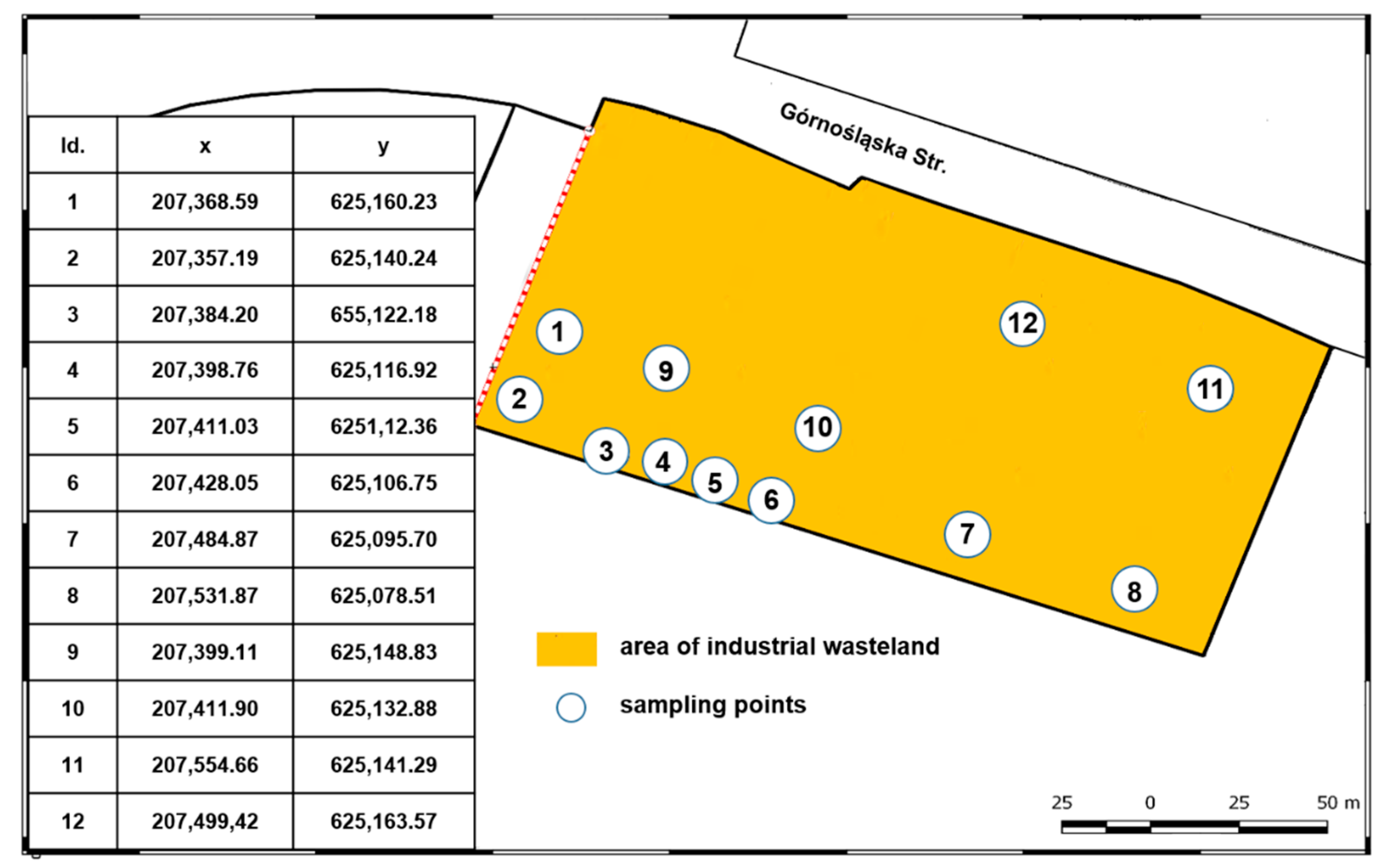
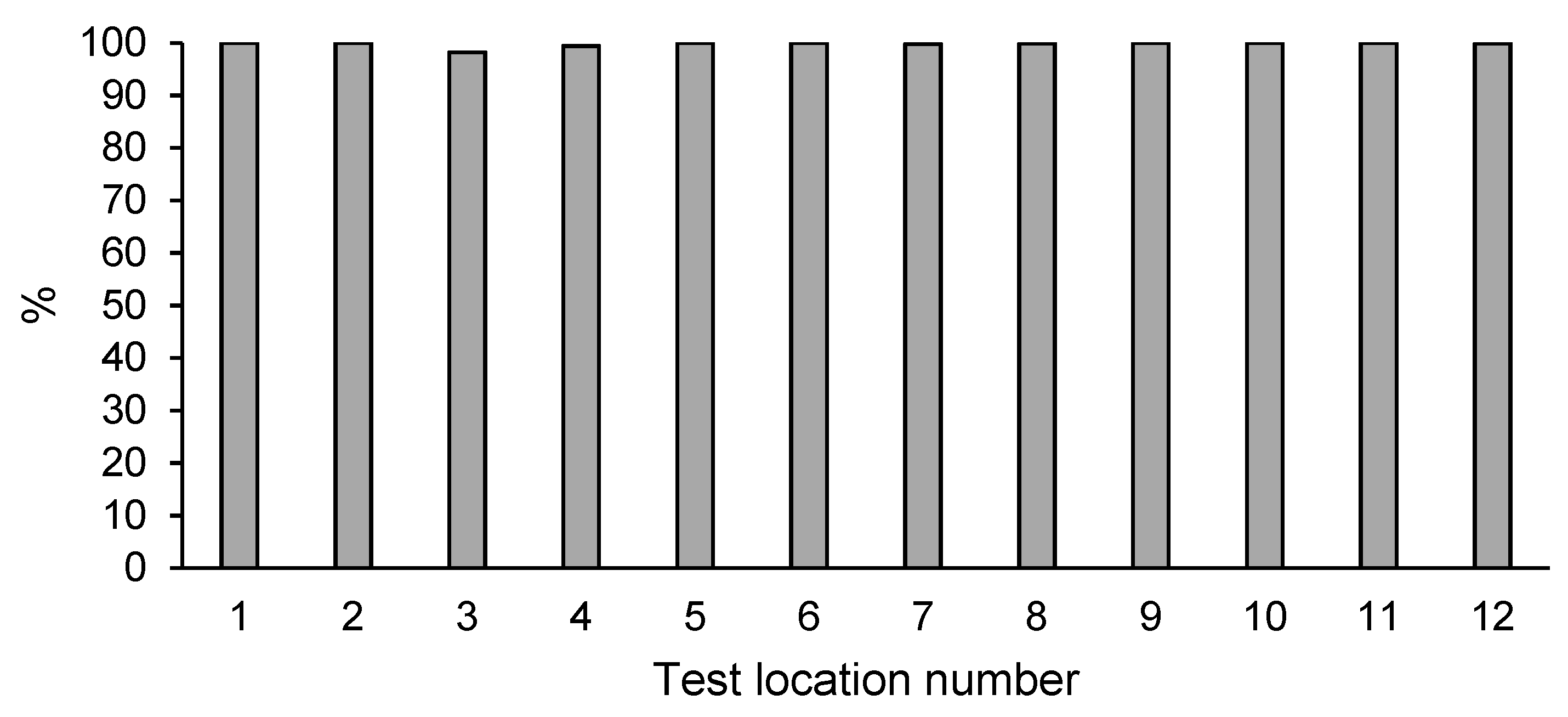
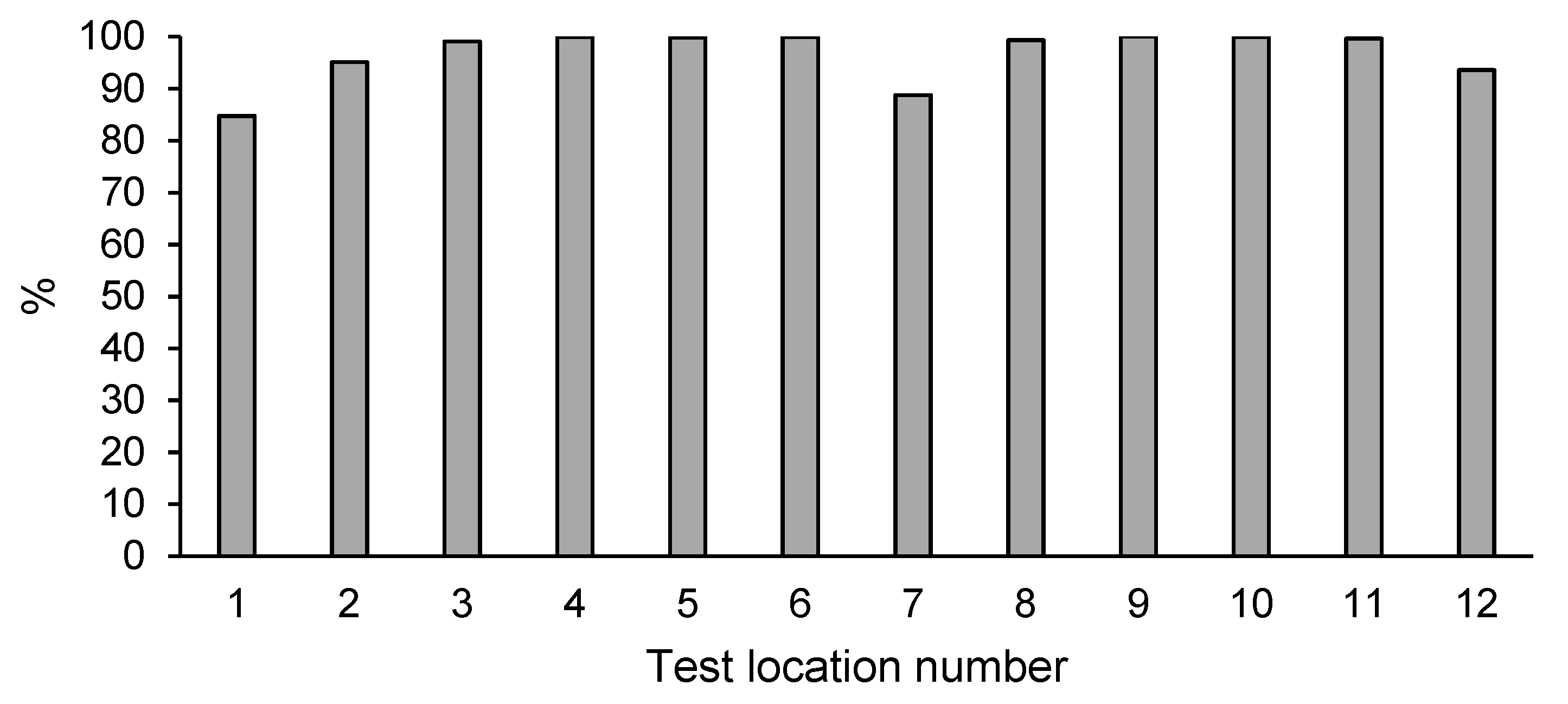
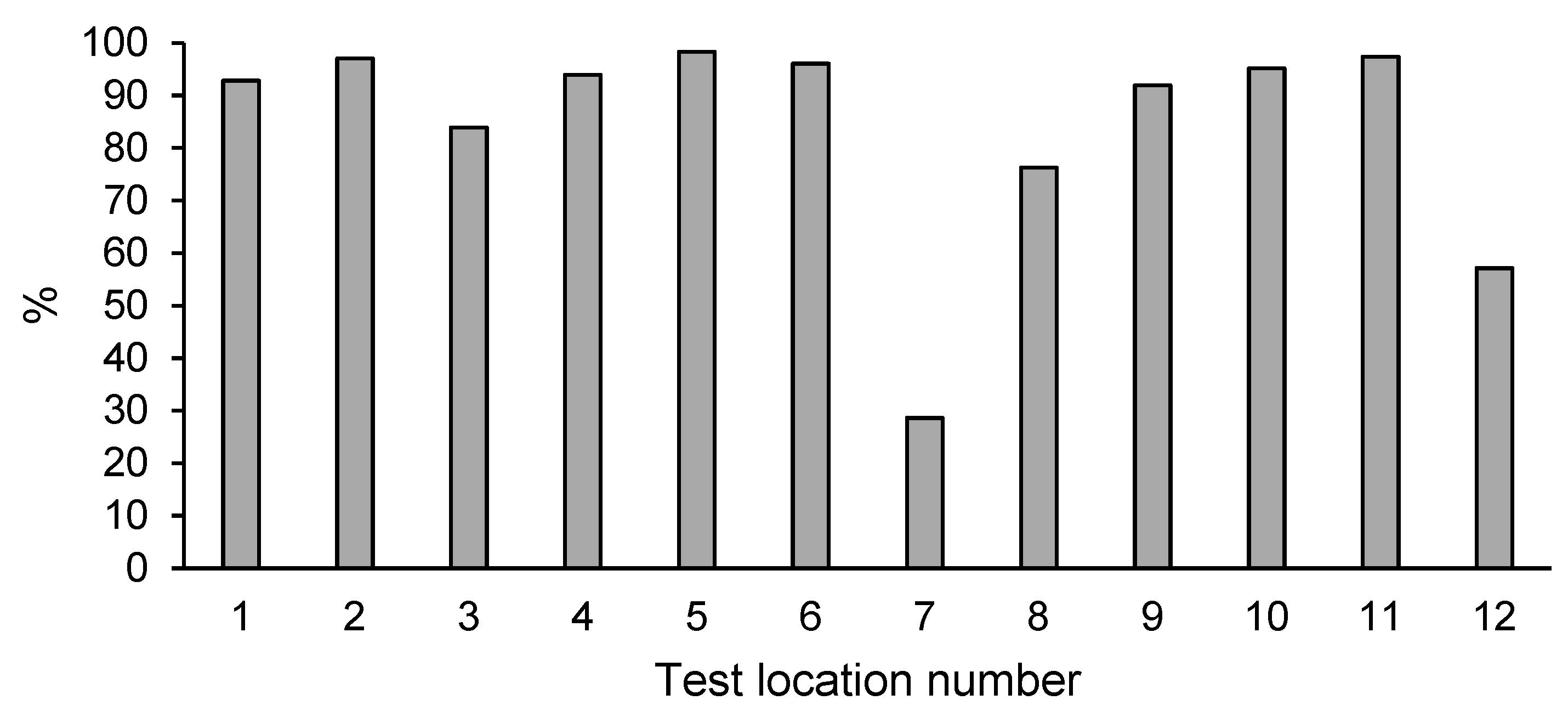
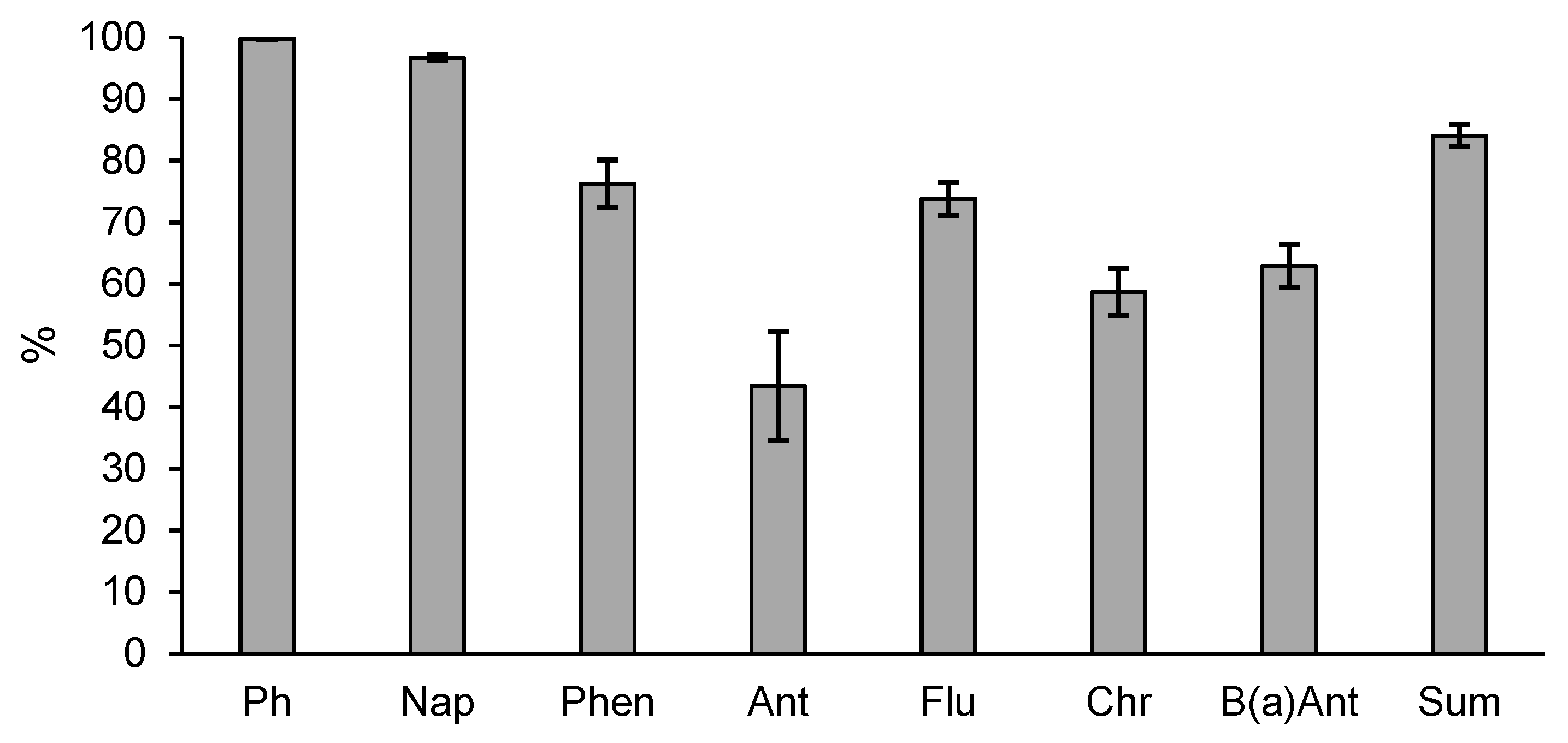
| Substance | Minimum Value | Maximum Value | Limit Value | Number of Points with Exceeded Limit Value |
|---|---|---|---|---|
| Metals | ||||
| As | n/a | 6.00 | 60 | 0 |
| Cr | 2.60 | 8.98 | 500 | 0 |
| Zn | 70.4 | 102 | 1000 | 0 |
| Cd | n/a | 0.43 | 15 | 0 |
| Cu | 9.84 | 28.6 | 600 | 0 |
| Ni | 5.42 | 13.9 | 300 | 0 |
| Pb | 36.8 | 137 | 600 | 0 |
| Hg | 0.13 | 4.30 | 30 | 0 |
| Monoaromatic hydrocarbons (BTEX) | ||||
| Benzene | 0.02 | 1.80 | 100 | 0 |
| Toluene | 0.06 | 2.26 | 200 | 0 |
| Ethylbenzene | 0.02 | 1.41 | 200 | 0 |
| Xylenes | 0.26 | 5.70 | 100 | 0 |
| Styrene | 0.04 | 0.40 | 60 | 0 |
| Sum of BTEX | 0.40 | 11.4 | 200 | 0 |
| Polycyclic aromatic hydrocarbons (PAHs) | ||||
| Naphthalene | 1.51 | 266 | 50 | 9 |
| Phenanthrene | 8.44 | 229 | 50 | 10 |
| Anthracene | 6.96 | 116 | 50 | 3 |
| Fluoranthene | 26.7 | 190 | 50 | 6 |
| Chrysene | 8.79 | 100 | 50 | 3 |
| Benzo(a)anthracene | 8.18 | 134 | 50 | 5 |
| Benzo(a)pyrene | 6.91 | 35.0 | 50 | 0 |
| Benzo(a)fluoranthene | 2.14 | 9.79 | 50 | 0 |
| Benzo(g,h,i)perylene | 2.95 | 12.8 | 50 | 0 |
| Sum of PAHs | 174 | 1235 | 250 | 11 |
| Others | ||||
| Free cyanides | n/a | n/a | 40 | 0 |
| Complex cyanides | 0.02 | 0.23 | 40 | 0 |
| Phenols | 11.2 | 188 | 50 | 6 |
| Test Location Number | Content in 2015 | Content in 2020 |
|---|---|---|
| 1 | 20.0 | n/a |
| 2 | 16.9 | n/a |
| 3 | 13.7 | 0.25 |
| 4 | 11.2 | 0.07 |
| 5 | 14.4 | n/a |
| 6 | 13.0 | n/a |
| 7 | 138 | 0.22 |
| 8 | 132 | 0.08 |
| 9 | 103 | n/a |
| 10 | 147 | n/a |
| 11 | 169 | n/a |
| 12 | 188 | 0.17 |
| Test Location Number | Content in 2015 | Content in 2020 |
|---|---|---|
| 1 | 1.53 | 0.23 |
| 2 | 36.7 | 1.79 |
| 3 | 132 | 1.22 |
| 4 | 145 | 0.04 |
| 5 | 152 | 0.18 |
| 6 | 170 | 0.08 |
| 7 | 71.3 | 7.99 |
| 8 | 222 | 1.46 |
| 9 | 5.52 | n/a |
| 10 | 74.9 | 0.07 |
| 11 | 261 | 0.95 |
| 12 | 266 | 17.0 |
| Test Location Number | Phenanthrene | Anthracene | ||
|---|---|---|---|---|
| Content in 2015 | Content in 2020 | Content in 2015 | Content in 2020 | |
| 1 | 8.44 | 0.70 | 6.96 | 0.15 |
| 2 | 25.1 | 0.72 | 18.0 | 0.09 |
| 3 | 70.3 | 5.47 | 116 | 6.12 |
| 4 | 42.1 | 1.66 | 18.4 | 0.58 |
| 5 | 85.7 | 0.53 | 16.1 | 0.11 |
| 6 | 79.0 | 2.27 | 27.3 | 0.59 |
| 7 | 160 | 232 | 43.9 | 133 |
| 8 | 143 | 23.1 | 28.9 | 67.5 |
| 9 | 73.1 | 0.80 | 22.2 | 0.07 |
| 10 | 143 | 1.01 | 32.7 | 0.13 |
| 11 | 183 | 4.92 | 65.1 | 6.54 |
| 12 | 229 | 212 | 93.4 | 110 |
| Test Location Number | Fluoranthene | Chrysene | Benzo(a)anthracene | |||
|---|---|---|---|---|---|---|
| Content in 2015 | Content in 2020 | Content in 2015 | Content in 2020 | Content in 2015 | Content in 2020 | |
| 1 | 31.8 | 1.77 | 13.8 | 2.26 | 10.4 | 1.98 |
| 2 | 28.4 | 1.46 | 12.3 | 0.96 | 9.26 | 0.77 |
| 3 | 28.2 | 8.39 | 9.59 | 9.62 | 8.67 | 9.94 |
| 4 | 26.7 | 3.93 | 10.1 | 4.55 | 9.24 | 3.48 |
| 5 | 32.0 | 1.54 | 8.79 | 1.19 | 8.18 | 1.10 |
| 6 | 37.0 | 4.64 | 10.5 | 2.55 | 10.5 | 2.31 |
| 7 | 114 | 105 | 47.7 | 75.6 | 57.2 | 75.5 |
| 8 | 111 | 73.5 | 40.1 | 24.4 | 51.4 | 21.5 |
| 9 | 108 | 0.32 | 35.9 | 7.41 | 34.4 | 6.38 |
| 10 | 104 | 0.92 | 55.0 | 6.81 | 54.9 | 6.56 |
| 11 | 134 | 9.62 | 93.7 | 8.62 | 91.7 | 4.87 |
| 12 | 190 | 142 | 100 | 27.3 | 135 | 28.2 |
| Test Location Number | Content in 2015 | Content in 2020 |
|---|---|---|
| 1 | 174 | 12.5 |
| 2 | 257 | 7.45 |
| 3 | 527 | 85.1 |
| 4 | 468 | 28.5 |
| 5 | 491 | 8.46 |
| 6 | 503 | 19.8 |
| 7 | 903 | 645 |
| 8 | 897 | 213 |
| 9 | 501 | 40.4 |
| 10 | 915 | 44.3 |
| 11 | 1819 | 47.4 |
| 12 | 1235 | 530 |
Publisher’s Note: MDPI stays neutral with regard to jurisdictional claims in published maps and institutional affiliations. |
© 2021 by the authors. Licensee MDPI, Basel, Switzerland. This article is an open access article distributed under the terms and conditions of the Creative Commons Attribution (CC BY) license (http://creativecommons.org/licenses/by/4.0/).
Share and Cite
Telesiński, A.; Kiepas-Kokot, A. Five-Year Enhanced Natural Attenuation of Historically Coal-Tar-Contaminated Soil: Analysis of Polycyclic Aromatic Hydrocarbon and Phenol Contents. Int. J. Environ. Res. Public Health 2021, 18, 2265. https://doi.org/10.3390/ijerph18052265
Telesiński A, Kiepas-Kokot A. Five-Year Enhanced Natural Attenuation of Historically Coal-Tar-Contaminated Soil: Analysis of Polycyclic Aromatic Hydrocarbon and Phenol Contents. International Journal of Environmental Research and Public Health. 2021; 18(5):2265. https://doi.org/10.3390/ijerph18052265
Chicago/Turabian StyleTelesiński, Arkadiusz, and Anna Kiepas-Kokot. 2021. "Five-Year Enhanced Natural Attenuation of Historically Coal-Tar-Contaminated Soil: Analysis of Polycyclic Aromatic Hydrocarbon and Phenol Contents" International Journal of Environmental Research and Public Health 18, no. 5: 2265. https://doi.org/10.3390/ijerph18052265
APA StyleTelesiński, A., & Kiepas-Kokot, A. (2021). Five-Year Enhanced Natural Attenuation of Historically Coal-Tar-Contaminated Soil: Analysis of Polycyclic Aromatic Hydrocarbon and Phenol Contents. International Journal of Environmental Research and Public Health, 18(5), 2265. https://doi.org/10.3390/ijerph18052265







